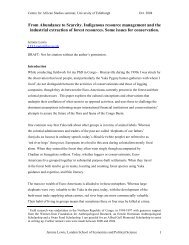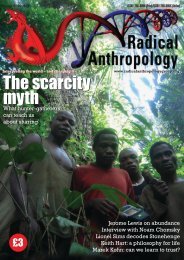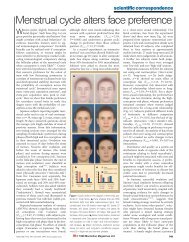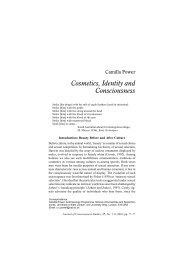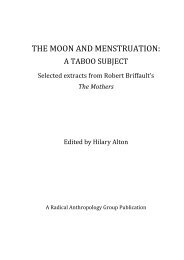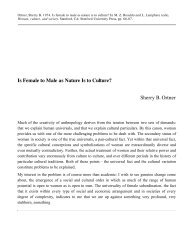Language and life history: A new perspective on the development ...
Language and life history: A new perspective on the development ...
Language and life history: A new perspective on the development ...
- No tags were found...
You also want an ePaper? Increase the reach of your titles
YUMPU automatically turns print PDFs into web optimized ePapers that Google loves.
Resp<strong>on</strong>se/Locke & Bogin: <str<strong>on</strong>g>Language</str<strong>on</strong>g> <str<strong>on</strong>g>and</str<strong>on</strong>g> <str<strong>on</strong>g>life</str<strong>on</strong>g> <str<strong>on</strong>g>history</str<strong>on</strong>g>as does “performative” (e.g., Edwards & Sienkewicz 1990;Finnegan 1969; Linell 1982). This is unsurprising since <strong>the</strong>phenomena in questi<strong>on</strong> involve verbal artistry <str<strong>on</strong>g>and</str<strong>on</strong>g> an audience.Still, to ensure that readers would not c<strong>on</strong>fuse ourmeaning with Austin’s, we referred to pragmatics <str<strong>on</strong>g>and</str<strong>on</strong>g> performancefive times. In secti<strong>on</strong> 2.8 of <strong>the</strong> target article, wepointed out that a number of verbal functi<strong>on</strong>s that bel<strong>on</strong>gto <strong>the</strong> performative functi<strong>on</strong> (e.g., joking, mollifying) falloutside <strong>the</strong> area of pragmatics as usually defined, <str<strong>on</strong>g>and</str<strong>on</strong>g> insecti<strong>on</strong> 10 (title “Pragmatics <str<strong>on</strong>g>and</str<strong>on</strong>g> performance”), wefur<strong>the</strong>r discuss <strong>the</strong>se categories.Knight & Power imply that we erred in claiming that“performative applicati<strong>on</strong>s of language, in <strong>the</strong> form ofspeech <str<strong>on</strong>g>and</str<strong>on</strong>g> voice, c<strong>on</strong>sistently favor males.” Evidencefrom <strong>the</strong> (heavily Western) anthropological literature indicatesthat males are, in fact, more likely to engage in publicdisplays of vocal <str<strong>on</strong>g>and</str<strong>on</strong>g> verbal prowess than females. Thereare cultures where both men <str<strong>on</strong>g>and</str<strong>on</strong>g> women speak inpublic, but we have yet to find a culture where <strong>the</strong> maledominance pattern is reversed, <str<strong>on</strong>g>and</str<strong>on</strong>g> would expect to findfew in which females outperform males in ag<strong>on</strong>isticdisplays.Knight & Power suggest that any evoluti<strong>on</strong>aryaccounts based <strong>on</strong> male dominance in <strong>the</strong> public displayof vocal <str<strong>on</strong>g>and</str<strong>on</strong>g> verbal behavior are necessarily limited,since <strong>the</strong>se would <strong>on</strong>ly take place in hierarchical or stratifiedsocieties. If this were true, it would be difficult tosquare with anthropological accounts. C<strong>on</strong>sider, forexample, <strong>the</strong> s<strong>on</strong>g duels of <strong>the</strong> Hindi-speaking FijiIndians, an “unstratified” society in Bhatga<strong>on</strong>. In <strong>the</strong>seduels, sung by men in groups of three to six, <strong>the</strong> “singersusually attack, insult, <str<strong>on</strong>g>and</str<strong>on</strong>g> sl<str<strong>on</strong>g>and</str<strong>on</strong>g>er <strong>the</strong> religi<strong>on</strong>, relatives,<str<strong>on</strong>g>and</str<strong>on</strong>g> pers<strong>on</strong>s of <strong>the</strong>ir opp<strong>on</strong>ents,” attempting “to lower<strong>the</strong> prestige of <strong>the</strong>ir opp<strong>on</strong>ents <str<strong>on</strong>g>and</str<strong>on</strong>g> <strong>the</strong>ir opp<strong>on</strong>ents’ religi<strong>on</strong>”(Brenneis & Padarath 1975, p. 283). “Despite anapparent lack of stratificati<strong>on</strong>,” <strong>the</strong> authors c<strong>on</strong>clude,“<strong>the</strong> nature of <strong>on</strong>e’s st<str<strong>on</strong>g>and</str<strong>on</strong>g>ing relative to o<strong>the</strong>r men is arecurring c<strong>on</strong>cern for villagers” (p. 284, emphasis added).In <strong>the</strong> target article, we claimed that “important aspectsof language cannot appear until sexual maturity.” Knight& Power chose to c<strong>on</strong>flate this claim with an equallyunc<strong>on</strong>troversial statement in secti<strong>on</strong> 10, that “<strong>the</strong> abilityto infer intenti<strong>on</strong>s presupposes real-world knowledge,”(sect. 10, para. 2) <str<strong>on</strong>g>and</str<strong>on</strong>g> <strong>the</strong>n drew <strong>the</strong> c<strong>on</strong>clusi<strong>on</strong> that <strong>the</strong>knowledge we had in mind had something to do withsexual behavior. It does not. What we stated is that pragmaticsis <strong>the</strong> last area of language to develop, <str<strong>on</strong>g>and</str<strong>on</strong>g> mustbe, because it depends <strong>on</strong> knowledge that could not bepresent until <strong>the</strong> individual had witnessed, <str<strong>on</strong>g>and</str<strong>on</strong>g> engagedin, behaviors that typically emerge in <strong>the</strong> run up to adulthood.The knowledge we had in mind c<strong>on</strong>cerned <strong>the</strong>social, ec<strong>on</strong>omic, political, <str<strong>on</strong>g>and</str<strong>on</strong>g> physical world as it can<strong>on</strong>ly be known to those who interact with it outside of<strong>the</strong> familial c<strong>on</strong>text, with some degree of aut<strong>on</strong>omy.Knight & Power again merge separate statements fromsecti<strong>on</strong> 6. There, we pointed out that <strong>the</strong> verbal dueling ofmales may be supported by testoster<strong>on</strong>e, which is relatedto dominance <str<strong>on</strong>g>and</str<strong>on</strong>g> aggressi<strong>on</strong> (Puts et al. 2005), <str<strong>on</strong>g>and</str<strong>on</strong>g> that itmay be adaptive for <strong>the</strong>m to use verbal sport <str<strong>on</strong>g>and</str<strong>on</strong>g> humor inplace of physical combat. Knight & Power take this tomean that in females, lower levels of testoster<strong>on</strong>e aresomehow resp<strong>on</strong>sible for <strong>the</strong> documented gossip preferenceassociated with that sex; <strong>the</strong>y <strong>the</strong>n interpret gossip,as a means of disseminating socially relevant informati<strong>on</strong>,to be syntactically more complex than <strong>the</strong> elaborate verbalperformances of males.There are at least two things to say here. The first is thatin males, testoster<strong>on</strong>e c<strong>on</strong>tributes to aggressi<strong>on</strong>, which isfrequently exercised physically (Dabbs 2000). To avoidphysically harming each o<strong>the</strong>r, some o<strong>the</strong>r behaviormust be substituted. Marsh (1978) has described <strong>the</strong>“aggro” of young British men, a cerem<strong>on</strong>ial display ofphysical posturing <str<strong>on</strong>g>and</str<strong>on</strong>g> verbal taunting that expressesaggravati<strong>on</strong> in a fairly harmless manner. Aggro, hewrites, “is an all-male affair ... females are irrelevant –<strong>the</strong>y form no part of <strong>the</strong> cerem<strong>on</strong>y <str<strong>on</strong>g>and</str<strong>on</strong>g>, more importantly,<strong>the</strong>y are not legitimate objects of attack. There is noc<strong>on</strong>flict here except with o<strong>the</strong>r males” (Marsh 1978,p. 28). It is widely recognized that male adolescents <str<strong>on</strong>g>and</str<strong>on</strong>g>young men need ways to avoid physically injuring eacho<strong>the</strong>r. Although this can be accomplished with n<strong>on</strong>verbalas well as verbal displays (Kochman 1969; 1983; Marsh1978), in practice, <strong>the</strong> two work toge<strong>the</strong>r. Street gangsthat are physically violent have a high rate of verbalduels (Short & Strodtbeck 1965).Although aggrieved members of both sexes swear at,scold, scorn, <str<strong>on</strong>g>and</str<strong>on</strong>g> chastise o<strong>the</strong>rs, <strong>the</strong> sec<strong>on</strong>d thing t<strong>on</strong>ote is <strong>the</strong> str<strong>on</strong>g tendency of females to engage ingossip – a private verbal behavior used primarily or exclusivelywith o<strong>the</strong>r females – to lower <strong>the</strong> status of perceivedopp<strong>on</strong>ents, <str<strong>on</strong>g>and</str<strong>on</strong>g> to do so during <strong>the</strong> same <str<strong>on</strong>g>life</str<strong>on</strong>g> <str<strong>on</strong>g>history</str<strong>on</strong>g> stages,juvenility <str<strong>on</strong>g>and</str<strong>on</strong>g> adolescence, in which males engage inverbal duels – public verbal behavior used primarily orexclusively with o<strong>the</strong>r males – in an effort to competefor status <str<strong>on</strong>g>and</str<strong>on</strong>g> o<strong>the</strong>r resources. However, in our referenceto gossip (sect. 6), we pointed out that <strong>the</strong> str<strong>on</strong>ger femaledispositi<strong>on</strong> to gossip “may have to do with <strong>the</strong> fact thatgossip serves an affiliative functi<strong>on</strong>,” <str<strong>on</strong>g>and</str<strong>on</strong>g> that females, intimes of stress, “tend to come toge<strong>the</strong>r,” turning to eacho<strong>the</strong>r “for mutual aid” (sect. 6, para. 2, emphasis added).It was in this c<strong>on</strong>text that we discussed sexually dimorphicapplicati<strong>on</strong>s of speech.In searching for <strong>the</strong> biological bases of such differences<strong>the</strong>re are plenty of places to look. C<strong>on</strong>sider <strong>the</strong> birthprocess. In <strong>the</strong> o<strong>the</strong>r primates, <strong>the</strong>re appears to be a tendencyto give birth al<strong>on</strong>e. Women, <strong>on</strong> <strong>the</strong> o<strong>the</strong>r h<str<strong>on</strong>g>and</str<strong>on</strong>g>, seekeach o<strong>the</strong>r out at <strong>the</strong> time of childbirth (Trevathan 1999;Walrath 2003). Even in <strong>the</strong> case of apparent c<strong>on</strong>tradicti<strong>on</strong>sto this pattern, <strong>the</strong> woman typically does not leave <strong>the</strong>group for her first child, or go too far to summ<strong>on</strong> help ifneeded (Biesele 1997).If women gossip more than men, Knight & Power say,this should give <strong>the</strong>m an advantage in <strong>the</strong> area of syntax,but this takes several things for granted. First, it assumesthat gossip is syntactically complex. We accept that itmay be. Sec<strong>on</strong>d, it assumes that <strong>the</strong> more public displaysof verbal prowess by male speakers are syntacticallydeficient. To our knowledge, no such evidence exists.Indeed, <strong>the</strong> reports indicate that <strong>the</strong> more powerful individualsin traditi<strong>on</strong>al societies are unusually expert inmanipulating sentential material.Studies of babo<strong>on</strong>s indicate that here, too, females areless aggressive than <strong>the</strong>ir male counterparts. Seyfarth(1976) has reported that <strong>the</strong> ratio of approach-retreatinteracti<strong>on</strong>s to bouts of overt aggressi<strong>on</strong> is less than 2:1in males, but 20:1 in females. The affiliative functi<strong>on</strong> thatis fulfilled by human gossip may also have antecedents inn<strong>on</strong>human primates. Elsewhere, we have reviewed308 BEHAVIORAL AND BRAIN SCIENCES (2006) 29:3



